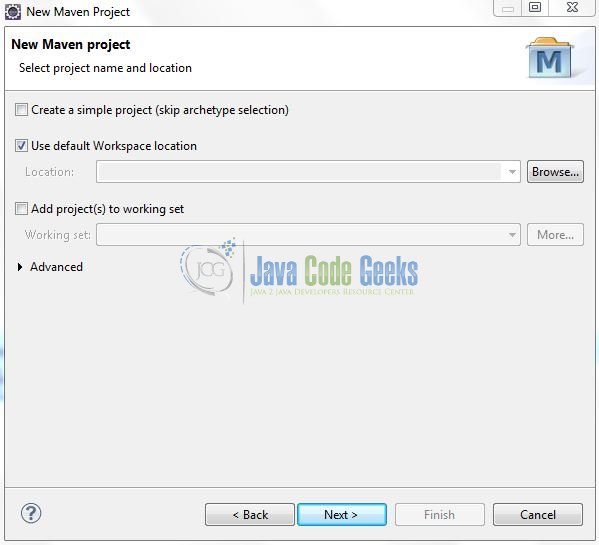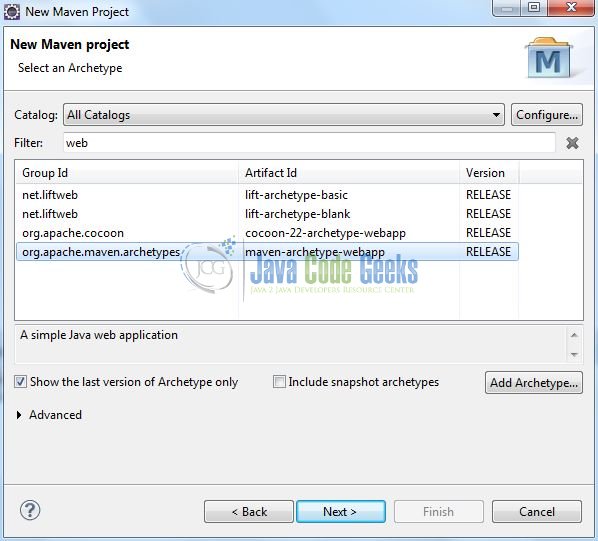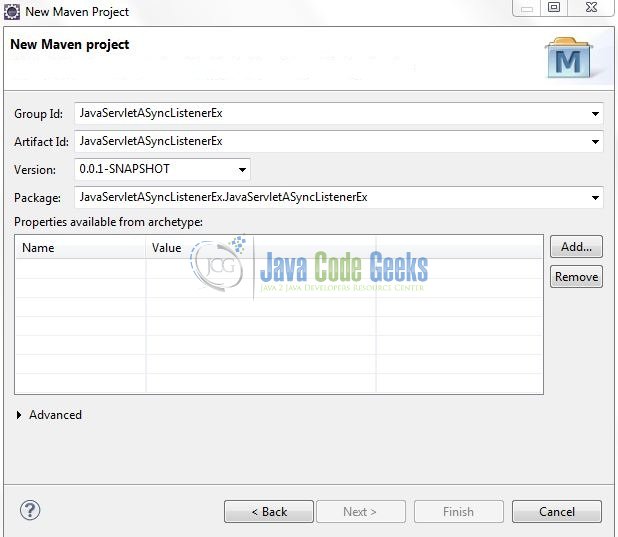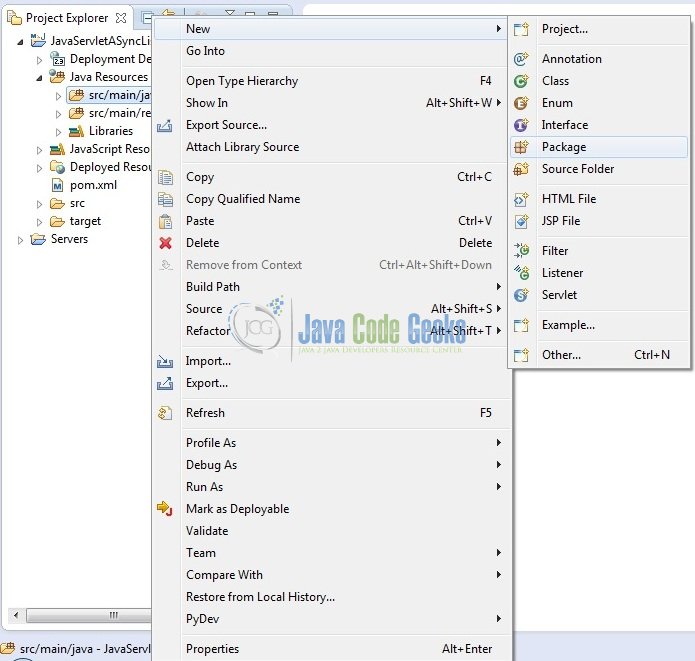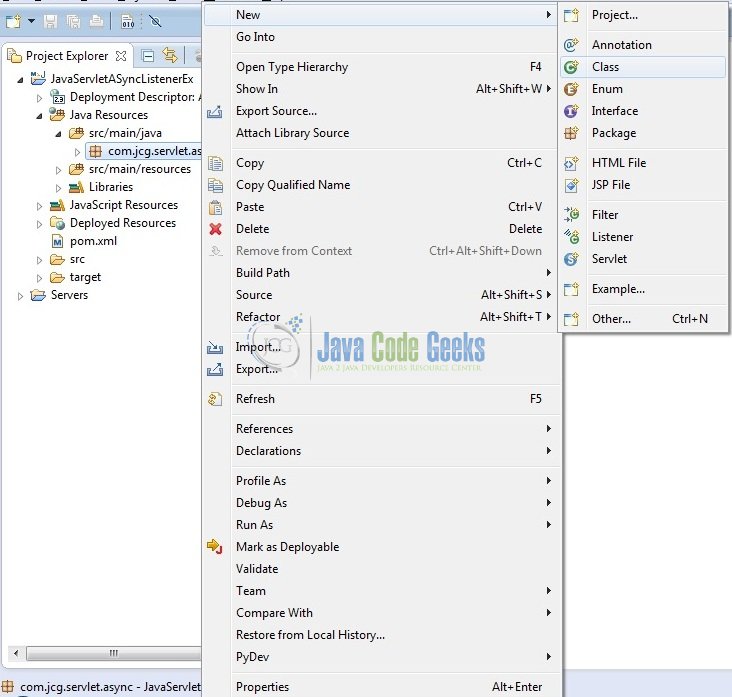Java Servlet AsyncListener Example
Async Servlet was introduced in Servlet 3.0. In this section, you will learn about registering AsyncListener with the recently created AsyncContext with an example. The AsyncListener will be notified when an asynchronous event occurs.
1. Introduction
AsyncEvent contains the details of the event occurred by the Asynchronous processes. These events include the successful completion of the asynchronous cycle, times out, or results in an error. The AsyncListener will receive an AsyncEvent (Asynchronous Event Object) when the above events (i.e. completion of the asynchronous cycle, times out, or results in an error) occurs. The AsyncListener will be notified of their creation or the addition order.
Now, open up the Eclipse Ide and let’s see how to implement the Servlet 3.0 Async Context!
2. Java Servlet Sync Context Example
Here is a step-by-step guide for implementing the Servlet Sync Context in Java.
2.1 Tools Used
We are using Eclipse Kepler SR2, JDK 8 and Maven. Having said that, we have tested the code against JDK 1.7 and it works well.
2.2 Project Structure
Firstly, let’s review the final project structure, in case you are confused about where you should create the corresponding files or folder later!
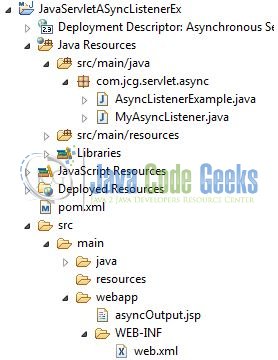
2.3 Project Creation
This section will demonstrate on how to create a Java-based Maven project with Eclipse. In Eclipse Ide, go to File -> New -> Maven Project.
In the New Maven Project window, it will ask you to select project location. By default, ‘Use default workspace location’ will be selected. Just click on next button to proceed.
Select the ‘Maven Web App’ Archetype from the list of options and click next.
It will ask you to ‘Enter the group and the artifact id for the project’. We will input the details as shown in the below image. The version number will be by default: 0.0.1-SNAPSHOT.
Click on Finish and the creation of a maven project is completed. If you observe, it has downloaded the maven dependencies and a pom.xml file will be created. It will have the following code:
pom.xml
<project xmlns="http://maven.apache.org/POM/4.0.0" xmlns:xsi="http://www.w3.org/2001/XMLSchema-instance" xsi:schemaLocation="http://maven.apache.org/POM/4.0.0 http://maven.apache.org/xsd/maven-4.0.0.xsd"> <modelVersion>4.0.0</modelVersion> <groupId>JavaServletASyncListenerEx</groupId> <artifactId>JavaServletASyncListenerEx</artifactId> <version>0.0.1-SNAPSHOT</version> <packaging>war</packaging> </project>
We can start adding the dependencies that developers want like Servlets, Junit etc. Let’s start building the application!
3. Application Building
Below are the steps involved in developing this application.
3.1 Maven Dependencies
Here, we specify the dependencies for the Servlet API. The rest dependencies will be automatically resolved by the Maven framework and the updated file will have the following code:
pom.xml
<project xmlns="http://maven.apache.org/POM/4.0.0" xmlns:xsi="http://www.w3.org/2001/XMLSchema-instance"
xsi:schemaLocation="http://maven.apache.org/POM/4.0.0 http://maven.apache.org/maven-v4_0_0.xsd">
<modelVersion>4.0.0</modelVersion>
<groupId>JavaServletASyncListenerEx</groupId>
<artifactId>JavaServletASyncListenerEx</artifactId>
<packaging>war</packaging>
<version>0.0.1-SNAPSHOT</version>
<name>JavaServletASyncListenerEx Maven Webapp</name>
<url>http://maven.apache.org</url>
<dependencies>
<dependency>
<groupId>javax.servlet</groupId>
<artifactId>javax.servlet-api</artifactId>
<version>3.1.0</version>
</dependency>
</dependencies>
<build>
<finalName>${project.artifactId}</finalName>
</build>
</project>
3.2 Java Class Creation
Let’s create the required Java files. Right-click on src/main/java folder, New -> Package.
A new pop window will open where we will enter the package name as: com.jcg.servlet.async.
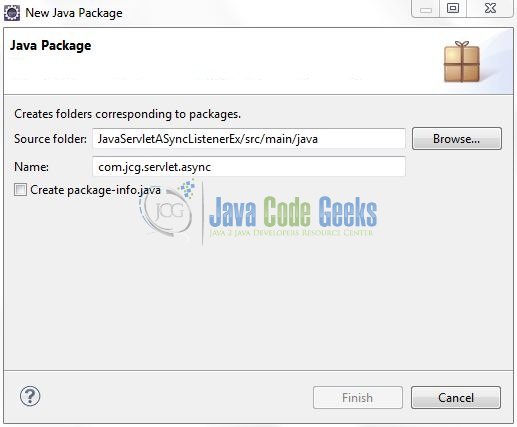
Once the package is created in the application, we will need to create the controller classes. Right-click on the newly created package: New -> Class.
A new pop window will open and enter the file name as: AsyncListenerExample. The Servlet Controller class will be created inside the package: com.jcg.servlet.async.
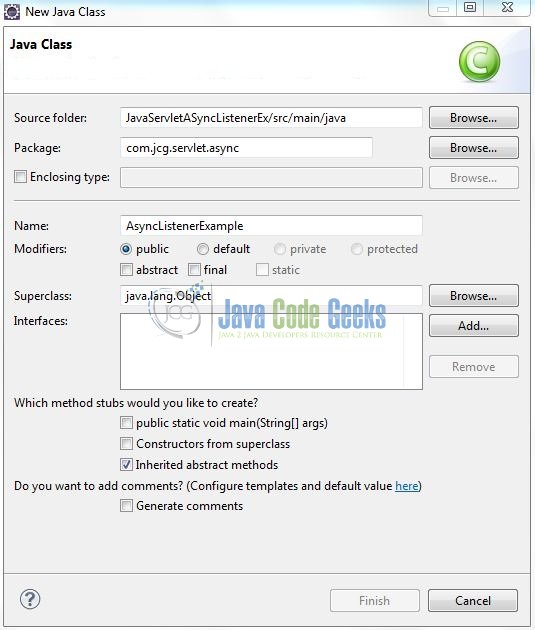
Repeat the step (i.e. Fig. 8) and enter the filename as: MyAsyncListener. The Listener class will be created inside the package: com.jcg.servlet.async.
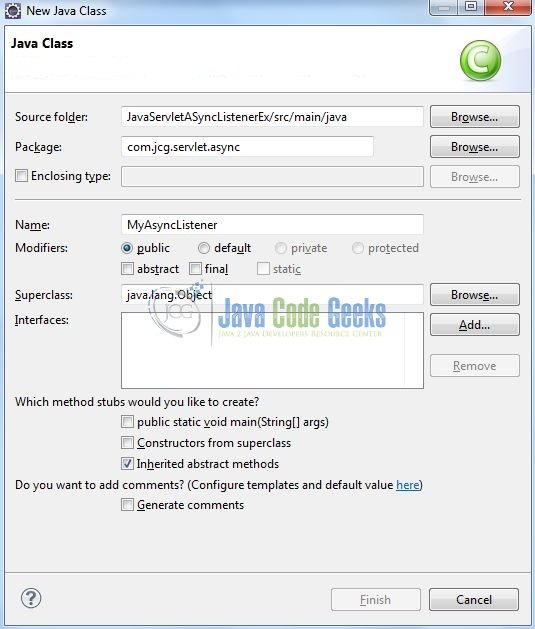
3.2.1 Implementation of Controller Class
In this example, developers will learn how to initialize the AsyncListenerExample using the ServletRequest object and dispatch the request and response objects of the AsyncContext to a given URL. Let’s see the simple code snippet that follows this implementation.
AsyncListenerExample.java
package com.jcg.servlet.async;
import java.io.IOException;
import java.io.PrintWriter;
import java.util.Date;
import javax.servlet.AsyncContext;
import javax.servlet.ServletException;
import javax.servlet.ServletRequest;
import javax.servlet.annotation.WebServlet;
import javax.servlet.http.HttpServlet;
import javax.servlet.http.HttpServletRequest;
import javax.servlet.http.HttpServletResponse;
@WebServlet(urlPatterns = "/AsyncListenerExample", asyncSupported = true)
public class AsyncListenerExample extends HttpServlet {
private static final long serialVersionUID = 1L;
public void doPost(HttpServletRequest req, HttpServletResponse resp) throws ServletException, IOException {
doGet(req, resp);
}
public void doGet(HttpServletRequest req, HttpServletResponse resp) throws ServletException, IOException {
Date dateObj = new Date();
resp.setContentType("text/html");
PrintWriter out = resp.getWriter();
out.print("<h2>AsyncListener Example </h2>");
req.setAttribute("receivedAt", dateObj);
out.println("Request Time?= " + req.getAttribute("receivedAt"));
AsyncContext asyncCtx = req.startAsync();
ServletRequest servReq = asyncCtx.getRequest();
servReq.setAttribute("ServletName", "AsyncListenerExample");
/**** Adding 'AsyncListener' Named As 'MyAsyncListener' ****/
asyncCtx.addListener(new MyAsyncListener());
asyncCtx.setTimeout(10000);
boolean isAsyncSupported = req.isAsyncSupported();
// This Will Return True
out.println("<br>AsyncSupported?= " + isAsyncSupported);
asyncCtx.complete();
boolean isAsyncStarted = servReq.isAsyncStarted();
// This Will Return True
out.println("<br>AsyncStarted?= " + isAsyncStarted);
if (isAsyncStarted) {
asyncCtx.dispatch("/asyncOutput.jsp");
}
}
}
3.2.2 Implementation of Listener Class
In the given example below, AsyncListener (i.e. MyAsyncListener) is added to AsyncContext in the AsyncListenerExample.java class using the addListener() method. On the different asynchronous events, MyAsyncListener is notified through the AsyncEvent object. MyAsyncListener displays the logged information on the console.
AsyncListenerExample.java
package com.jcg.servlet.async;
import javax.servlet.AsyncEvent;
import javax.servlet.AsyncListener;
public class MyAsyncListener implements AsyncListener {
// Public Constructor Is Required By Servlet Spec
public MyAsyncListener() {}
public void onComplete(AsyncEvent ae) {
System.out.println("AsyncListener :: 'onComplete' For Request?= " + ae.getAsyncContext().getRequest().getAttribute("ServletName"));
}
public void onTimeout(AsyncEvent ae) {
System.out.println("AsyncListener :: 'onTimeout' For Request");
}
public void onError(AsyncEvent ae) {
System.out.println("AsyncListener :: 'onError' For Request");
}
public void onStartAsync(AsyncEvent ae) {
System.out.println("AsyncListener :: 'onStartAsync'");
}
}
3.3 Creating JSP Views
Servlet 3.0 supports many types of views for the different presentation technologies. These include: JSP, HTML, XML etc. So let us write a simple view in JavaServletASyncContextEx/src/main/webapp/. Add the following code to it:
asyncOutput.jsp
<!DOCTYPE html PUBLIC "-//W3C//DTD HTML 4.01 Transitional//EN" "http://www.w3.org/TR/html4/loose.dtd"> <html> <head> <title>Asynchronous Servlet 3.0 Example</title> <meta http-equiv="Content-Type" content="text/html; charset=UTF-8"> </head> <body> <h3>Given Above Is The Servlet 3.0 AsyncContext Interface Dispatch() Method Example</h3> </body> </html>
4. Run the Application
As we are ready for all the changes, let us compile the project and deploy the application on the Tomcat7 server. To deploy the application on Tomat7, right-click on the project and navigate to Run as -> Run on Server.
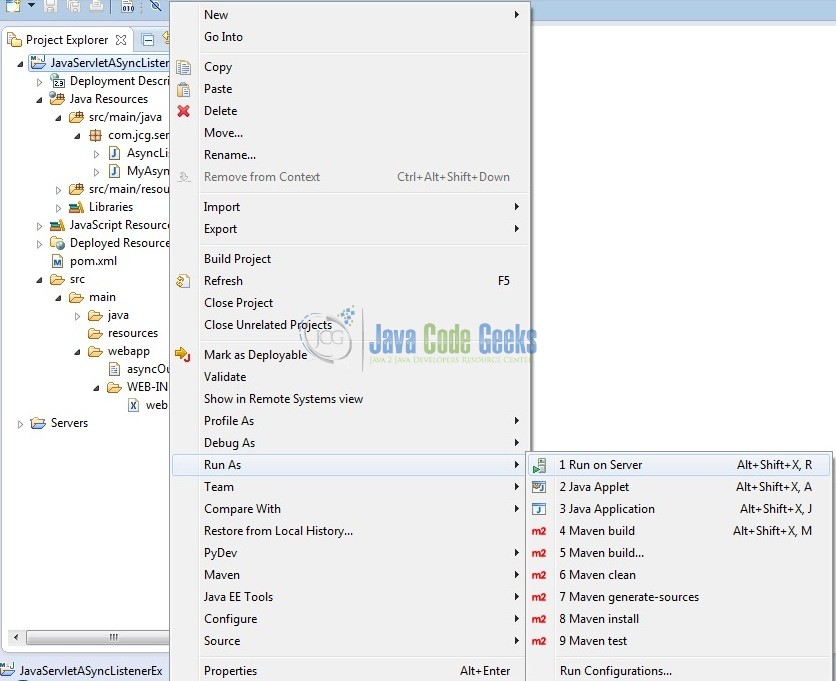
Tomcat will deploy the application in its web-apps folder and shall start its execution to deploy the project so that we can go ahead and test it in the browser.
5. Project Demo
Open your favorite browser and hit the following URL. The output page will be displayed.
http://localhost:8085/JavaServletASyncListenerEx/AsyncListenerExample
Server name (localhost) and port (8085) may vary as per your tomcat configuration. Developers can debug the example and see what happens after every step. Enjoy!
In the console, we will get the following output:
AsyncListener :: 'onComplete' For Request?= AsyncListenerExample
That’s all for this post. Happy Learning!!
6. Conclusion
In this section, developers learned how to implement the AsyncListener in a Servlet. Developers can download the sample application as an Eclipse project in the Downloads section. I hope this article served you with whatever developers were looking for.
7. Download the Eclipse Project
This was an example of AsyncListener in a Servlet.
You can download the full source code of this example here: JavaServletASyncListenerEx


